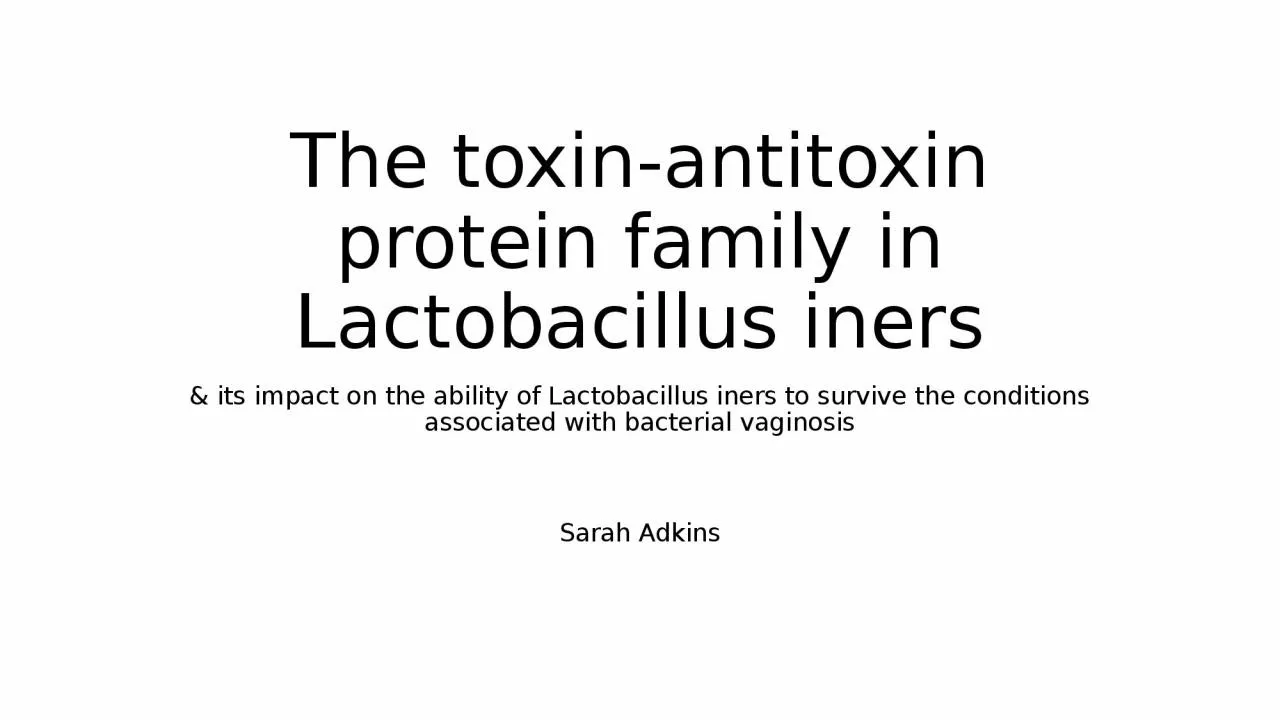

iners amp its impact on the ability of Lactobacillus iners to survive the conditions associated with bacterial vaginosis Sarah Adkins The Vaginal Microbiome Huang Fettweis Brooks et al The Changing Landscape of the Vaginal Microbiome ID: 914635
Download Presentation The PPT/PDF document "The toxin-antitoxin protein family in La..." is the property of its rightful owner. Permission is granted to download and print the materials on this web site for personal, non-commercial use only, and to display it on your personal computer provided you do not modify the materials and that you retain all copyright notices contained in the materials. By downloading content from our website, you accept the terms of this agreement.
Slide1
The toxin-antitoxin protein family in Lactobacillus iners
& its impact on the ability of Lactobacillus
iners
to survive the conditions associated with bacterial vaginosis
Sarah Adkins
Slide2The Vaginal Microbiome
Huang,
Fettweis
, Brooks et al. The Changing Landscape of the Vaginal Microbiome.
Clin
Lab Med. 2014 Dec;34(4):747-61.
Slide3Lactobacillus iners
Macklaim
,
Gloor
,
Anukam
et al. At the crossroads of vaginal health and disease, the genome sequence of Lactobacillus
iners
AB-1. Proc Natl
Acad
Sci
U S A. 2011 Mar 15;108
Suppl
1:4688-95.
Slide4Mendes-Soares
et al
Genes over and under-represented in vaginal Lactobacillus species relative to other Lactobacilli strains
Slide5Yamaguchi & Inouye. Regulation of growth and death in Escherichia coli by toxin-antitoxin systems. Nature Reviews Microbiology
9
, 779-790 (November 2011
).
ReIEB
toxin-antitoxin system
Slide6Specialized Persister Cells & the Mechanism of Multidrug Tolerance in Escherichia coli
Induced expression of the ReIE toxin
Subjected E. coli cells to antibiotics
Spotted cells on an agar plate which induced expression of ReIB antitoxin
Counted numbers of surviving persister cell colonies
Number of surviving persister cells was 10 to 10,000 times higher when toxin was expressed before adding antibiotics
(aside from
Mitomycin
C)
Slide7Does the toxin-antitoxin protein family present in Lactobacillus iners
play a part in its ability to survive the conditions associated with bacterial vaginosis?
Slide8The Experiment
Knock out the toxin and antitoxin genes
Use an expression vector to insert toxin gene into the genome where it can be forcibly expressed using a promotor
Create an artificial microbiome
Add Lactobacillus
iners
to microbiome and induce expression of toxin
Use 16s
rRNA
analysis to analyze relative abundance of bacteria in microbiome comparing wild-type, absence of antitoxin strain, absence of toxin-antitoxin strain
Slide9Creating the strains
Recombineering will be used to create knockout & forced expression strains
Sawitzke
, Thomason,
Bubunenko
et al. Recombineering: using drug cassettes to knock out genes in vivo. Methods
Enzymol
. 2013;533:79-102.
Slide10Making the artificial microbiome
Bacteria:
G. vaginalis, A.
vaginae
, M.
mulieris
, P.
bivia
,
Veillonella
sp.,
Peptostreptococcus
sp.,
Peptoniphilus
sp., & F.
nucleatum.
These bacteria will be obtained using the techniques specified in Patterson et al and added to the epithelial cells in equal concentrations along with Lactobacillus
iners
.
This microbiome is not a direct replica of the vaginal microbiome.
Slide1116s rDNA analysis
After toxin expression is induced and an experimentally determined amount of time has passed, 16s rDNA analysis will be used.
16s rDNA V1-V3 hypervariable regions will be amplified using PCR.
-These regions are highly conserved throughout bacterial species, and the small changes in the sequences over time allow for the classification of species.
This will give us an idea of the relative abundance of each bacteria present in the cultures.
Slide12If the forced expression strain of Lactobacillus iners
is more abundant in its artificial microbiome than the knockout strain, I will be able to conclude that the
ReIEB
toxin-antitoxin protein family plays a role in the ability of Lactobacillus
iners
to survive in the conditions associated with bacterial vaginosis.
Slide13Bibliography
Macklaim
,
Fernandes
, Bella, Hammond, Hammond, Reid,
Gloor
. Comparative meta-RNA-
seq
of the vaginal microbiota and differential expression by Lactobacillus
iners
in health and
dysbiosis
. Microbiome: 2013: 1: 12.
http://www.ncbi.nlm.nih.gov/pmc/articles/PMC3971606/
Mendes-
Soares
, Suzuki, Hickey et al. Comparative Functional Genomics of Lactobacillus spp. Reveals Possible Mechanisms for Specialization of Vaginal Lactobacilli to Their Environment. J.
Bacteriol
. April 2014 vol. 196 no. 7 1458-1470. http://jb.asm.org/content/196/7/1458.full
Unterholzner
,
Poppenberger
,
Rozhon
. Toxin-antitoxin systems. Mob Genet Elements. 2013 Sep 1; 3(5): e26219.
http://www.ncbi.nlm.nih.gov/pmc/articles/PMC3827094/
Petrof
,
Gloor
,
Vanner
et al. Stool substitute transplant therapy for the eradication of Clostridium difficile infection: ‘
RePOOPulating
’ the gut. Microbiome: 2013: 1: 3.
http://microbiomejournal.biomedcentral.com/articles/10.1186/2049-2618-1-3
Keren, Shah,
Spoering
et al. Specialized Persister Cells and the Mechanism of Multidrug Tolerance in Escherichia coli. J
Bacteriol
. 2004 Dec;186(24):8172-80.
http://www-ncbi-nlm-nih-gov.proxy.library.vcu.edu/pmc/articles/PMC532439/
Patterson, Stull-Lane,
Girerd
et al. Analysis of adherence, biofilm formation and
cytotoxicity suggests a greater virulence potential of
Gardnerella
vaginalis relative to other bacterial vaginosis-associated anaerobes. Microbiology (2010), 156, 392–399.
http://www.ncbi.nlm.nih.gov/pmc/articles/PMC2890091/pdf/392.pdf
Fettweis
, Brooks, Serrano et al. Differences in vaginal microbiome in African American women versus women of European ancestry. Microbiology (2015), 160: 2272-2282.
http://mic.microbiologyresearch.org/content/journal/micro
Fettweis
, Serrano,
Girerd
et al. A New Era of the Vaginal Microbiome: Advances using Next-Generation Sequencing.
Chem
Biodivers
. 2012 May; 9(5): 965–976.
http://www.ncbi.nlm.nih.gov/pmc/articles/PMC3517151/#R5
Huang,
Fettweis
, Brooks et al. The Changing Landscape of the Vaginal Microbiome.
Clin
Lab Med. 2014 Dec;34(4):747-61.
http://www-ncbi-nlm-nih-gov.proxy.library.vcu.edu/pubmed/?term=The+Changing+Landscape+of+the+Vaginal+Microbiome
Kuczynski
,
Lauber
, Walters et al. Experimental and analytical tools for studying the human microbiome. Nature Reviews Genetics, 2011, Vol.13(1), p.47.
http://www.nature.com/nrg/journal/v13/n1/pdf/nrg3129.pdf